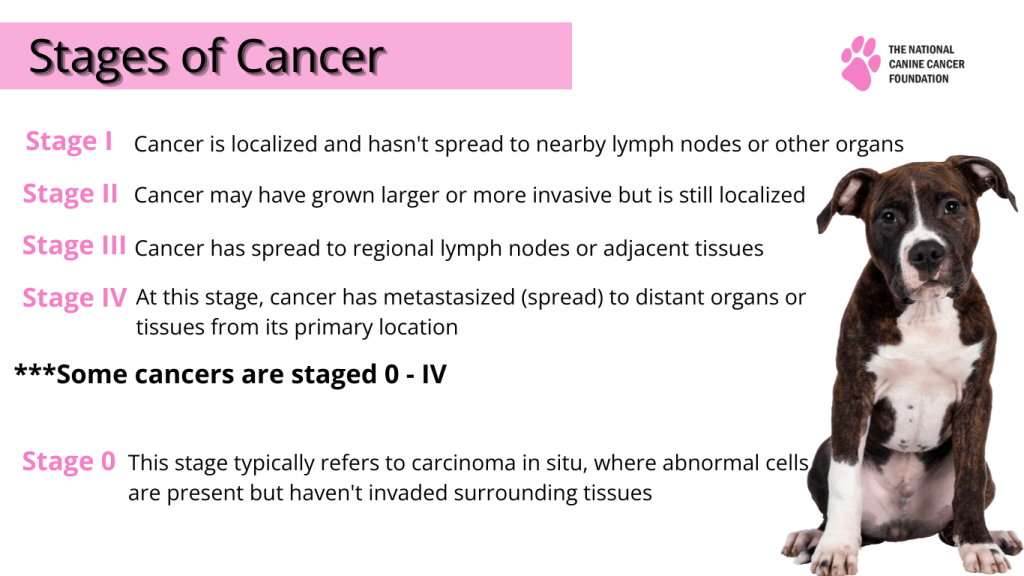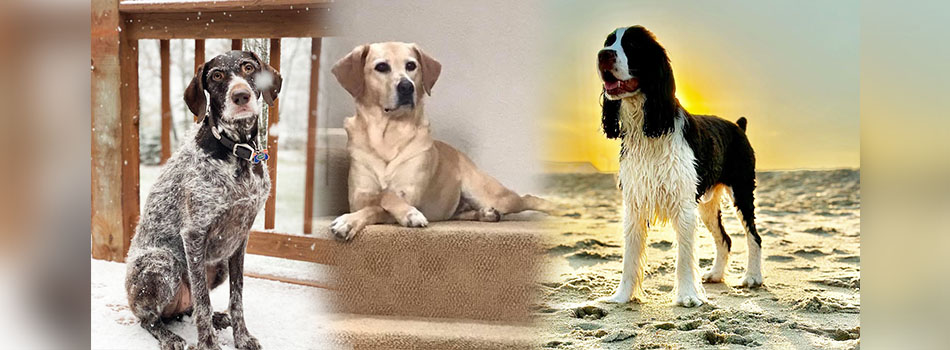The staging of cancer in dogs allows you to know how large the tumor is and how far it has spread from the original site of the cancer. This question can be a little hard to answer when we talk about dogs.
Human cancer and dog cancer do share some similarities which can help each side when it comes to research. However, when it comes to staging the two staging scales don’t necessarily match.
Cancers in dogs can act very differently when they spread, metastasize, and cause harm in the body in ways that don’t fit into the typical understanding of cancer stages. Another challenge is that dogs can’t directly communicate about their symptoms. By the time you notice that they are in pain, it has probably advanced past stage I or II.
Since each canine cancer is different in how acts, the staging system must relate to each cancer differently. However, most cancers are staged I – IV.
Dog Cancer Stages
- Stage I – Cancer is localized and hasn’t spread to nearby lymph nodes or other organs.
- Stage II – Cancer may have grown larger or more invasive but is still localized.
- Stage III – Cancer has typically spread to regional lymph nodes or adjacent tissues
- Stage IV – At this stage, cancer has metastasized (spread) to distant organs or tissues from its primary location
In some cancers, there is a stage 0. This stage typically refers to carcinoma in situ, where abnormal cells are present but haven’t invaded surrounding tissues.
One thing to remember is that stage and grade are two different things. Stage refers to the size of the tumor and how far it has spread from where it first developed. Grade refers to how cancerous the cells look under a microscope with a biopsy or cytology depending on the cancer. 
Why does knowing the stage of cancer help?
Veterinarians use dog cancer stages for several reasons:
- Determines treatment options.
- Helps predict the prognosis.
- Standardizes communication.
- Guidance for follow-up care.
The stages of dog cancer will help your vet to determine your treatment options. Treatment varies greatly depending on the cancer and the stage of the cancer. For example, early-stage cancer can be treated with minimally invasive surgery and no chemo, while advanced-stage cancer might require a combination of therapies like surgery, radiation, chemo, or even amputation.
Knowing the stage of the cancer allows your vet some insight into the likely course of the disease. It also helps the veterinarian estimate the prognosis for recurrence, treatment effectiveness, and long-term quality of life.
Having a staging system allows veterinarians and canine oncologists to be on the same page as they develop treatment plans and walk the owners through what will be needed for their dogs.
Finally, the staging system allows for follow-up care plans or even end-of-life care plans to be thought of and shaped by the type of cancer and the stage of cancer that has been diagnosed.
The specifics of staging criteria can vary between different types of cancer, but it broadly standardizes a framework for assessing the extent of cancer and guiding treatment decisions.
Some people wonder: what are the stages of dog cancer leading to death? This is something that can be talked about with your veterinarian once they have been able to assess the whole picture of your dog.
While stage IV is certainly worse than stage I, the big picture of what the end will look like ultimately depends on the type of cancer and the current health of your dog as you approach treatment options.
How are the dog cancer stages determined?
Cancer staging is determined by testing. These are some of the tests used to determine the stage:
- Physical exam
- Bloodwork with pathology review
- Biopsies
- Radiographs
- CT scans
- Ultrasounds
Once the testing is completed your vet needs to interpret the data to be able to give you a more accurate description of your dog’s health. Here are some of the factors that they include as they are evaluating the data for you.
- Tumor size
- Spread of tumor
- Metastasis of tumor
- Grade of tumor cells
- Weight loss
- Extreme lethargy
Another question that is often asked by pet parents is what are the dog cancer end-stage symptoms? The answer to this question is different for each case and is dependent on the factors mentioned above as well as the type of cancer, age of the dog, and current health of the dog. 
Why are the stages of canine lymphoma unique?
Lymphatic cancer is one of the top five cancers, it accounts for twenty percent of all dog cancers. Lymphoma originates in the lymphatic system and spreads throughout the body quickly, thus never being a “localized” cancer.
Lymphoma is so common and varied some veterinary oncologists have developed a special staging standard based on where it was found and the frequency. Here is the Lymphoma staging breakdown:
- Stage I – Is found in only one lymph node
- Stage II – Is found on one side of the lymphatic system (front of body or rear of body)
- Stage III – Is found throughout the lymphatic system
- Stage IV – Is found in the liver and/or spleen
- Stage V – Is found in the bone marrow, nervous system, or other unusual location
There are five different types of Lymphoma, Alimentary, Cutaneous, Extra Nodal, Mediastinal, and Multi-centric Central Nervous System Lymphoma. For more information on Lymphoma and where to find the lymph nodes, please check the canine cancer library on the site.
Staging cancer takes many factors into account. It is important for you to have a conversation with your vet during this process about how you feel your dog is feeling compared to his normal mood or activity level.
This is where having the Check Your Dog Wellness Journal could also help a great deal with what has been happening in the previous months. It is during this time frame with your vet, as you formulate a plan for your dog that you can talk frankly about what will happen in the future so you will know what to look for as the cancer progresses or regresses.
Ask the hard questions now, so you can have a clear picture in your mind. The hope is always for your pup to defeat cancer! You and your vet will be working closely together, but in the end, it will be you, the pet parent, who knows your dog the best and when the time will be to stop treatment and say goodbye.
Related Articles:
Lymphoma is the Most Common Dog Cancer
Where Are Lymph Nodes In Dogs And How Do You Check Them?
When To Say Goodbye To Your Dog With Cancer
The Top Ten Warning Signs of Cancer Exposed


Recent Comments